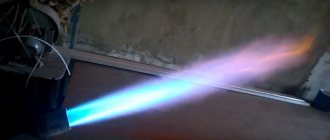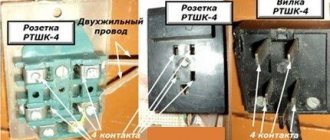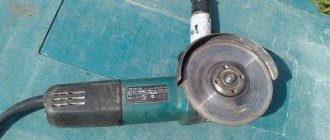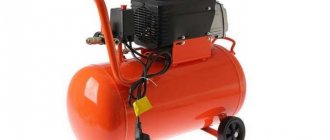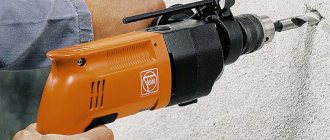Gas burners for roof repairs: review of popular models + selection tips
When repairing roofing coverings, it is often necessary to use hot air and even fire: to melt bitumen, melt the underside of roofing felt, and even solder the edge of a metal sheet.
And for this you already need special tools. But why not just set the same roofing felt on fire with a homemade torch if our goal is to melt the bitumen? The fact is that you won't succeed this way. How do you direct the fire in the right direction, especially when there is wind? And how long will such torches last, since the work of laying the roof will be serious? These two main functions are performed by a gas burner. And now we’ll tell you how to choose it.
What are gas burners for roofing?
A gas burner is an indispensable thing when repairing a roof. It not only lays sheets of roofing felt, but also heats up the mastic and even seals small seams and holes. Here is a complete list of all operations:
- Cutting and soldering of metal elements.
- Removing the old layer of paint.
- Sealing small cracks.
- Melting mastic.
- Heating sheets before laying.
- Strengthening butt seams.
A typical roofing gas burner consists of a comfortable handle, a tube that supplies gas, and a metal cup at the end. A hose is connected to a special connector on the handle, and the required amount of gas is supplied to it from the cylinder. And you need to regulate the pressure through the valve on the reducer.
In practice, everything is simple: we press the handle lever, the gas enters the hose, and at the outlet of the glass, a combustion of a mixture of gas and air is formed, which we first ignite with a match. The flame temperature is so high that it can reach 1500°C! Using a valve, you can regulate not only the strength of the flame, but also its length.
Conventional gas burners are light enough - within 1-1.5 kg - so that you can easily hold them in your hand and not drop them from fatigue. And the role of the glass is precisely to shape the flow of flame in the desired direction. The design of the glass is precisely shaped in order to maximally protect the flame from being blown out by the wind. Moreover, both the glass and the handle are made differently for different burner models. Although they have the same operating principle: starting a gas burner is no more difficult than a kitchen burner - using an ordinary match or lighter.
Almost all modern gas burners for roofing provide a means of adjusting operating modes: standby mode and operating mode. The standby mode is designed specifically to save fuel.
Different models of modern gas burners differ from each other primarily in the principle of mixing air into the gas. Older burners are connected to an oxygen cylinder, while modern ones can take air from the atmosphere, which is more convenient, of course. Even the gas the burners use can vary. There, most often propane is used, but there are also units that run purely on methane. But we will also note other differences, based on which you can make the right choice.
Standard gas burner in action:
Propane tank in the cold
- Log in to reply to this topic
#1 Svetla
- Top
- Insert nickname
#2 Isperyanc
Cylinder and hoses for the night in a warm place. A large cylinder is better for this.
- 3
- Top
- Insert nickname
#3 SergDemin
come up with something like a constant weak heater for my current cylinder.
It will definitely help, the main thing here is not to overheat. And as Isperyanc correctly said, the balloon is large. It has a higher heat capacity and will heat up and cool down more slowly. In Soviet times there were electric heating pads. There is a low-power heating cable. It would be just right, a couple of pieces for a large cylinder.
- 1
- Top
- Insert nickname
#4 G_Kar
- Participant
- Messages: 2,239
- Tomsk city
There is a self-regulating heating cable, in any large hardware store or specialized one, select it according to the temperature so that it does not heat up more than 30-40 (it seems that they go to the pipes - there are 15 degrees), wind several turns on the cylinder with the outlet to the reducer so that it also heated, on top - isolon with a foil layer, foil inside. Not a budget option, of course, but effective.
Post edited by G_Kar: 14 November 2022 10:30
- 6
My work on Instagram: @MOV_engineering
- Top
- Insert nickname
#5 Svetla
Thanks for answers! Isn’t it dangerous to bring the cylinder into a warm place from the cold? I'm afraid of running into a low-quality refill (in terms of volume, not weight). The temperature difference will be from the room +24 to the cold - 5. And back.
> - what does > mean? What should be (or should not be) the temperature next to the cylinder, which was previously standing in the cold? Should I just buy a convection heater and turn it on an hour before starting work? And if I do the cylinder as recommended by G-Kara, should I constantly maintain the warm temperature of the cylinder, or turn it on an hour before work? And I planned to change the cylinder. Is it worth buying a composite one right away? Thank you again for your answers, this is real help!
- Top
- Insert nickname
#6 Isperyanc
Light, be sure to bring in the hoses.
- Top
- Insert nickname
#7 mechanic1102
There is a self-regulating heating cable,
- Top
- Insert nickname
#8 G_Kar
- Tomsk city
Isn’t it dangerous to bring the cylinder into a warm place from the cold? I'm afraid of running into a low-quality refill (in terms of volume, not weight). The temperature difference will be from the room +24 to the cold - 5. And back
- 3
My work on Instagram: @MOV_engineering
- Top
- Insert nickname
Which is better quality: professional or budget?
So, professional contractors purchase usually expensive professional gas burners that are reliable and safe to use. But for a home craftsman, a small, convenient tool without any additional pretensions will be suitable for equipping and repairing the roof of your own home. Will the quality of work be worse? Not at all! It’s just that such a gas burner is not suitable for industrial work, where it is used almost every day and where uninterrupted processes and absolute safety come first.
It is also not acceptable to have a situation where a team goes to a new facility (and, of course, deadlines are definitely running out), and the burner is defective. There is neither time nor reserve to stop everything and go out to purchase new equipment. Whereas, with careful handling in the hands of a home craftsman, even the most Chinese unit will serve faithfully for decades. Especially if you use it no more than once a season.
And in the end, when working with a massive professional burner or with a regular one, you will get the same result. But no matter how expensive and professional the gas burner is, before each use, be sure to check its connecting hose, the tightness of the connections and the clogging of the mouthpiece. Such problems do not occur often, but if you miss a defect, there is a risk of serious consequences.
Although, if you have an idea to buy the cheapest “lighter” (how much does it cost to cover a garage roof?), then we will hasten to dissuade you. The fact is that if a gas burner has a weak gearbox, then the fire will be no more useful than the same blowtorch. The work will proceed extremely slowly - while you heat one part of the sheet, the second will already have time to cool down. As a result, you will simply have to remove the gearbox and work without it at your own peril and risk.
Precautionary measures.
Before installing the gearbox, you need to make sure that there are no cracks or dents on the device on the body and parts, and check how tightly everything fits. Is the glass on the pressure gauge broken or cracked? The use of a gearbox is prohibited. Is the pressure gauge needle stationary even though gas is being supplied? This situation indicates that the device is defective or faulty. Have you carefully inspected the gearbox? Only now can it be turned on. First of all, we slowly open the cylinder valve, then on the reducer, and finally, turn the key on the gas-consuming device. We rotate the adjusting screw on the gearbox, adjusting the operating pressure. We carry out all actions smoothly and slowly, recording any changes, sounds, etc. In the opposite sequence - equipment, reducer, cylinder - turn off the valves.
The gear valve may become clogged, so we clean the gear valve at least twice a year. But it is better to do this with the help of a specialist. If during operation we discover even the slightest malfunction, stop using the device. It is important not to forget to close the valve and also release the gas from the reducer.
Source
Which is safer: compact or large?
At first glance, it seems that hauling a gas cylinder onto the roof is the most dangerous undertaking. Moreover, today you can purchase more compact versions of gas burners:
But in fact, it is precisely these cans that can cause burns and even fire. We are talking about counterfeit Chinese products, which are abundant in the construction market. A large cylinder is still located far from the operating burner, while a small cylinder is constantly in the high temperature zone, which is not at all safe. Decide for yourself!
One more point about safety. When choosing a gas burner for your roof, try to avoid counterfeits and overly cheap products - this is simply unsafe. So, the most common problem with such burners is that the operating pressure may be indicated in the technical data sheet as 0.05-0.08 MPa, but in reality it turns out to be up to 1.6 MPa, as in any propane burner. But the supplied gearbox is not at all designed for such parameters, and a closed valve may not withstand the pressure directly on the roof. Such a burner requires a gearbox, but an inexperienced user may simply not know about it.
Fire safety measures
Regardless of whether a factory gas burner is used or a homemade one, fire safety requirements must be strictly observed.
- Keep a fire extinguisher on the roof when performing roofing work.
- All work is carried out only during daylight hours.
- When laying a soft roof using a gas burner, only one propane cylinder can be placed on the roof.
- It must be avoided from heating up.
- The roofing material itself must not be overheated or ignited.
These are the simple conditions that guarantee the safety of construction operations involving roofing with fused materials. They are simple and easy to do, so there shouldn't be any problems.
Overview of market offers
Gas-air burners are the safest of their kind. Easy to use, lightweight and creates a flame of sufficiently high power. But the modern market also offers more standard options that work without oxygen. Choose the one you feel most comfortable working with:
GG-2U: comfortable and light
GG-2S: against strong winds
And this is already professional equipment. This burner runs on propane and differs from previous models in that it works great in strong winds. The whole secret is in its structure - two valves and two housings, with which it is easy to precisely regulate the operating mode.
GGS1-1.7: universal option
This model is considered universal in the construction world due to its light weight, size and high level of performance. It is convenient for drying roofs and fusing soft materials. If necessary, it is easy to create an intense flame of up to 400°C, which is especially valuable in repair work. But such a burner can only be used on horizontal sections of the roof.
GGK-1: for precision repairs
This model features a heavier and more durable glass for burning old paint and waterproofing the roof. Perhaps this is the most convenient model for roof repair, especially since gas is supplied to it using a lever.
GGS 1-1.0 burners are well suited for minor work, especially repairing junctions, but can also be used for laying waterproofing. But the GGS-1-0.5 series pleases with economical fuel consumption.
GGS-4-1.0: four bells
And for professional installation of roofing materials, the GGS-4-1.0 model is used, which is equipped with four sockets at once and can heat the entire roll at once - all that remains is to quickly roll it out. Significant savings of time and effort! Moreover, it is easy for even one person to cope with such work, but for the repair of just one or two roofs of private houses there is no point in purchasing such equipment.
GV-3: for repairing metal roofing
This propane torch is specially designed for heating metals and manually soldering them, its glass is only 50 mm in diameter.
GV-111R: for stripping
Another popular gas burner is GV-111R. It is especially convenient for repairing roofs with old paint that needs to be removed, and for melting rolled bitumen materials.
GV-550: for junctions
This model is more suitable than any other for repairing roof junction points. The maximum heating of bitumen using this tool is 300°C.
GV-900: heavy fire
The most convenient sample, which gives a maximum flame length of up to 900 mm. You can work while standing, at full height, which is comfortable for daily tasks.
GV-850: fine adjustment
This propane torch is equipped with a special valve, which makes it possible to precisely regulate the amount of gas and the length of the flame using a lever. But such a burner does not operate on gas alone—technical oxygen is necessarily used here.
GGS2-1.5: parallel sockets
This burner is equipped with two parallel high-output sockets.
And finally, let's talk separately about homemade burners, which today are also often used in roof repairs.
SIEVERT: modern version
How to make a gas burner yourself?
Like any other tool, you can also build such a burner with your own hands if you are confident in your future safety. But remember, a gas burner is a complex device, and it is important to follow all the rules.
In order to make a torch, you will need a divider and a metal rod - attach them to a handle made of special heat-resistant wood. Borrow a gas supply hose from the gas welding system. And finally, examine the unit for the slightest gas leaks - this is important!
Or everything can be done simpler for small roofing repairs (the result is a fairly powerful burner, note):
Obviously, it is better to buy a ready-made gas burner with all the certificates than to even entrust its manufacture to a good craftsman you know. Just when purchasing, pay attention to the material used to make the burner - only high quality! After all, any burner heats up to a fairly high temperature, and therefore the material must be ultra-strong. Next, look at the handle - it should be equipped with a holder made of durable wood or heat-resistant plastic. This is important if you don't want to get burned unexpectedly while working.
Source
Reducer for a propane tank - everything you need to know about this device
Content:
- General information.
- What is a propane reducer?
- How to choose a reducer for a propane cylinder used in everyday life?
- Precautionary measures.
Reducing the pressure of propane gas to the level required for a particular job is the main task that a reducer for a propane cylinder is designed to perform . Without this device, neither gas welding work nor the use of gas cylinders in everyday life would be possible. Below we will talk in detail about the structure, purpose and operating features of the gearbox for a propane cylinder.
General information.
Propane gas, which is naturally found in petroleum gases and is released during oil refining, is used by people for a variety of needs - both at home and at work. According to its chemical composition, propane is a saturated hydrocarbon, colorless and odorless.
- for gas welding works;
- for space heating;
- in construction;
- for gas household appliances;
- as one of the types of fuel for cars (considered cheaper and more environmentally friendly than gasoline and diesel fuel).
But since gas is a flammable explosive substance, special cylinders are used to store it in a compressed state. In the middle of the cylinder, the gas is under high pressure, and in order to release it outside, you need to regulate the gas pressure at the outlet of the cylinder. This function is performed by a reducer for a propane cylinder . In addition, the reducer maintains a stable level of operating pressure.
What is a propane reducer?
The design of the gearbox is simple. There is a membrane inside; the device is connected to a gas cylinder with a special nut. There is a key (screw), with which the pressure is adjusted to the required level. There is a pressure gauge on the gearbox, which displays the operating pressure level. On the other side of the reducer, a hose is put on to connect to the gas-consuming device. Propane cylinders are painted red, so the reducer should be the same color. Reducers for other gases have a different color. The gearbox weighs about 0.5 kg.
Propane reducer markings include:
- manufacturer (must be a trademark of the enterprise);
- gearbox brand;
- year of issue.
In addition, the gearbox is supplied with certificates of conformity and safety regulations.
How to choose a reducer for a propane cylinder used in everyday life?
The reducer for a propane cylinder is designed for use in temperate climates, therefore its use is permissible at temperatures from -15 to 45 degrees Celsius.
Operating principle
The operating principle of the gearbox depends on its type.
The direct reducer kit includes 2 chambers with high and low pressure zones, which are separated by rubber membranes . Such devices are equipped with fittings. Modern models are designed in such a way that the bellows line is integrated directly into the gearbox.
On sale you can find devices with a third fitting; it is intended for installing a pressure gauge.
The gas entering through the hose ends up inside the chamber. The generated pressure tries to open the valve. On the other hand, a spring locking mechanism exerts pressure on it, returning it to its original place. The valve prevents uncontrolled penetration of high pressure fuel coming from the cylinder.
The principle of operation of the reverse gearbox is the opposite of that described above. Gas enters the chamber and forms increased pressure. As it accumulates, it prevents the valve from opening. In order for fuel to enter the household device, it is necessary to change the position of the adjusting mechanism towards the right-hand thread.
Do you need a gearbox for a roof burner?
Call us: 8-909-З60-07-37 Write to us:
"Reliable Gas" store - sale of safe gas cylinders. Delivery across Russia.
- Composite gas cylinders
- Metal gas cylinders
- Disposable gas cylinders
- Gearboxes
- Gas ramps Cavagna Group
- Gas ramps Mondial Gnali Bocia
- Hoses, liners
- Gas ramps GOK
- Gas guns
- Gas generators
- Gas heaters
- Gas burners
- Tiles, grills
- Gas lamps
- Fittings, unions, adapters
- Gas taps
- Grill grates
LLC "Reliable Gas" Dimitrovgrad, Chkalova St., 45/1 INN 7329009264 OGRN 1137329000203
- Composite gas cylinders
- Metal gas cylinders
- Disposable gas cylinders
- Reducers Reducers for cylinders with Eurovalve KLF
- Reducers for cylinders with a Russian standard valve
- Gas ramps Cavagna Group
- Gas ramps Mondial Gnali Bocia
- Gas ramps GOK
- Hoses, liners
- Gas guns
- Gas generators
- Gas heaters
- Gas burners
- Tiles, grills
- Gas lamps
- Fittings, unions, adapters
- Gas taps
- Grill grates
Online store "Reliable Gas".Sale of safe certified polymer-composite cylinders.
Safety comes first.
Logos and trademarks used on the site belong to their respective owners.
Reducer BPO-5DM10, 6 mm (propane-butane) for roofing burners
Designed to reduce and regulate gas pressure - propane-butane coming from a cylinder, and automatically maintain a constant set operating pressure. Ideal for supplying propane-butane to gas-air burners of the GV and GVP types.
Maximum throughput, m3/h - 5.0 Maximum gas pressure at the inlet, MPa (kgf/cm2) - 2.5 (25) Operating gas pressure, MPa (kgf/cm2) - 0.2 (2.0) Connection to gearbox - M12x1.25LH Fitting: 6 mm Weight, no more, kg - 0.3
Which burner, cylinder and reducer should I buy for roof repair?
To be useful for something else later
Well, the burner is up to your taste. It could be simpler. I have six different ones (I used to work on roofing). Both homemade and purchased. I like Samopal better. I made it for myself. You can use a 40-liter cylinder. If you later take it to the dacha to use it. Or borrow someone’s thread for a while. A frog gearbox. I’ve never installed a gearbox at all. I fried it to the fullest. But this experience is needed. Take the material with fiberglass at least. Do not take it with fiberglass. It is not tensile strength. Roll the roll toward you. Then you can see how much you melt the base and the roll. Before applying the sticker, I rewound a roll of 100 HDPE pipe. Then it does not flatten and rolls evenly. You pull it towards you with a kind of stick. A stick with a hook at the end. If you have any questions, I will answer.
Mikael Thank you for sharing such subtleties. GLASS FABRIC AND GLASS CANVAS for me, even by ear, there was practically no difference. Then the logical question is what is GLASS FABRIC? I read about TechnoNIKOL - is this it?) Then I read about all sorts of safe plastic cylinders, like they don’t explode and they’re lightweight. Maybe they had experience? And how much container volume is usually needed to glue fiberglass on an area of about 25 square meters of the garage roof? And then I have one big bike from transport
If it’s not difficult, please tell me the brand of the burner and cylinder and the reducer)
Consumption of a propane cylinder for domestic purposes
When purchasing household propane cylinders, the question often arises: what will be the propane consumption?
To answer this question, you need to know the volume of gas in the cylinder.
*Data taken from the stamp on the cylinders.
Gas consumption in gas stoves
To determine how much gas your gas stove consumes, you need to refer to the technical documentation of the stove.
For example, a Hephaestus PG 900 gas stove with 4 burners has a maximum gas consumption of 486 g/h (or 0.486 kg/h). Therefore, if all 4 burners are turned on to maximum, then a 50-liter cylinder will last for 44 hours (the amount of gas in the cylinder is 21.5 kg divided by the flow rate of 0.486 kg/hour). Of course, if fewer burners are turned on, then gas consumption will decrease. Consequently, the cylinder will last for a longer period.
Gas consumption is calculated in the same way if in the technical documentation it is indicated in liters or cubic meters.
Gas consumption in boilers for heating a house.
The boiler's gas consumption is calculated similarly to the gas consumption in gas stoves.
Of the nuances, it should be noted that consumption strongly depends on the degree of insulation of your home, as well as on the ambient temperature. The less insulated the house is and the lower the temperature outside, the more energy the boiler needs to expend (burn gas) to heat the premises to the required temperature.
Connecting bottled gas at the dacha
There are always special requirements for working with gas. A small leak or improper operation may result in an explosion or fire. Therefore, leave the connection of the propane cylinder to the burner to specialists.
But if you have the necessary experience and knowledge, you can carry out the installation yourself.
To understand how to connect a cylinder to a stove, you need to follow a certain diagram:
- the gas container can be installed in the kitchen next to the stove. An outdoor location in a specialized metal cabinet is also suitable;
- the connection must be made through a special corrugated or rubber or gas hose;
- when connecting, the hose does not need to be pulled; its length should be 50-100 cm longer than the distance from the container to the tile;
- the maximum distance of the gas cylinder from the stove or heating battery must be at least 100 cm;
- the outdoor cabinet must be built on a concrete foundation, the height of which is 20-30 cm.
- place the container in living rooms;
- install the cylinder below floor level, since the gas is heavier than air and if there is a leak, it will not be able to evaporate, but will accumulate in the room;
- block a passage that can be used for evacuation in case of fire.
If the gas cylinder is placed in an outdoor closet in a private house, then you should know that when the air temperature drops below 0 ° C, the propane-butane mixture thickens. Then it will not be able to reach the tile. During the cold season, it is better to buy a winter mixture.
Specifics
As already noted, gearboxes can be domestic and industrial. Also universal models.
Consumer versions may not be customizable.
These are simple models. They are used in everyday life and outdoors. RDSG products are installed together with household gas cylinders. They have a very simple design. Due to this, gas can only be used in household stoves. These products are inexpensive and very reliable. There is also a Frog type gearbox, there is the RDSG-1 model. They should only be used in cylinders with a volume of 12 - 50 liters.
The class of universal, customizable gearboxes has a more complex design and greater potential. This is an excellent option for domestic use and for work in the home workshop. The products are attached to the cylinders using a threaded method and are fixed securely.
They have a pressure gauge and an adjustment screw that allows you to vary the functional pressure within the range of 0 - 0.3 MPa. Their highest throughput potential is 5 m 3 /hour.
The category of professional models is created from the best wear-resistant materials. They have the highest build quality and settings: 0.4 - 1.6 MPa.
Some modifications have two pressure gauges. They reflect input and functional pressure.
Often, many summer residents and hikers ask questions such as: is a reducer needed for a gas burner? And is a gearbox needed for a gas stove in the country? Stable and safe operation of any gas appliances and in any conditions is always necessary. Even if there is no urgent need for gearboxes, it won’t hurt to be on the safe side. It remains to decide which gearbox is needed for the gas stove.
Since the stove and burner are propane based, a propane reducer is needed. You need to select these products by studying them and comparing their characteristics. The key ones are:
- Purpose of the device.
- Functional pressure.
- Higher gas consumption.
- Attachment method.
- Planned operational life.
- Price.
Higher inlet pressure.
For example, if you plan to connect a desktop portable stove only on weekends, the gas consumption according to your calculations is 5 liters per month, then you need a 5 liter capacity and a Baltika RDSG-2 reducer.
For a static stove with an oven, a capacity of 27 or 50 liters is required. A suitable gearbox is the Frog RDSG-2.
Questions often arise here - what does a Frog gas reducer actually do? Why is it named like that? What is its purpose?
Why do you need a frog gas reducer? Its functions, like those of other gas reducers, are pressure stabilization, safety, etc.
Why frog? This device is direct. In it, gas flows through a fitting. The valve opens and is pressed against the seat by a spring. High pressure gas does not penetrate into the chamber. The diaphragm displaces the valve from this seat. The pressure gradually decreases to the operating values of the device to which the reducer is mounted.
The spring straightens. The valve is detached from the seat and does not interfere with gas flow. As the pressure increases, the spring presses the valve again, gas does not flow. This principle is reminiscent of frog jumping. And the device is similar in shape to it.
If it is necessary to connect a composite container to a thermal umbrella, it is better to use imported products with a KLF connector
The professional model BPO 5-3 Krass is optimally suited for gas welding in a home workshop. It guarantees a flow rate of a maximum of 5 m 3 per hour and allows you to adjust the operating pressure to 0.4 MPa. And for this task it has a flywheel and a pressure gauge. Thanks to the latter, it is possible to scrupulously assign pressure to the needs of gas welding equipment.
Design and purpose
Before looking for where to buy GR, you need to study its design and scope. This information will help you understand the general principle of operation of the device and simplify the process of choosing the appropriate model for any welding equipment.
Components of the GR design:
- External body;
- High and working pressure chambers;
- Filters of various types;
- Pressure disk;
- Pusher;
- Adjusting elements (screw, locknut, support washer);
- Compression spring;
- Connecting fittings;
- Membrane;
- Saddle
- Reducing and safety valve;
- Control devices (pressure gauge, rotameter).
The GR is a highly specialized device. Despite this, it simultaneously performs several important tasks to ensure the safety and normal operation of welding equipment.
Source
Gas-burner. The main tool for built-up waterproofing
Installing a soft roof using adhesive compounds is an unproductive task, especially if the covering area is more than 100 m2. Some types of coatings, for example, those made from oxidized bitumen on a glass-polymer base, are generally difficult to glue, and the strength of the seam turns out to be very low. However, there is an alternative - fusing a soft roof with a stream of open flame. The method is effective and universal, but its implementation requires a special gas burner for roofing work.
Classification of gas burners
Burners can be not only gas, but also liquid. In the latter case, they run on diesel fuel, but are less common, since their effectiveness appears only at ambient air temperatures reduced to +10...+15ºС.
Burners of this type are distinguished according to the following characteristics:
- According to the type of combustible mixture used. In addition to the mentioned liquid and gas ones, combined designs are also used, when air or oxygen is supplied to the working area simultaneously with flammable gas (propane and, much less frequently, acetylene).
- By the number of working nozzles. Gas burners for roofing work can have from 1 to 4 nozzles. In the latter case, the technological capabilities of the device are expanded (for example, the width of the roll material), but at the same time the consumption of combustible gas increases.
- By the presence or absence of a gearbox. Gearless burners, although structurally simpler, do not have the function of regulating the gas flow, which is inconvenient in the practice of their use.
- By the method of igniting a gas stream. Modern designs of the devices in question have a piezo ignition unit, which is much more functional than using a match or lighter for the same purposes.
- According to the design of the gas supply tube. It can be straight or bent at an angle, normal or shortened length.


